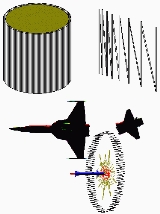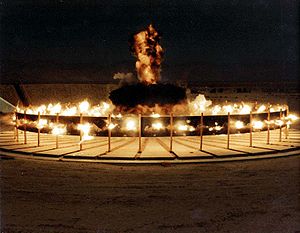
Continuous-rod warhead
Encyclopedia
A continuous-rod warhead is a specialized munition that exhibits an annular blast fragmentation pattern. It is used in anti-aircraft and anti-missile missiles.
and machine-gun bullet
s were used against early military aircraft during World War I
. Artillery
was used when aircraft flew above the range of rifle and machine-gun cartridges. Since the probability of actually striking the aircraft was small, artillery shells were designed to explode at the approximate altitude of the aircraft to throw a shower of fragments
in the vicinity of the explosion. Similar anti-aircraft weaponry with larger calibers, higher rates of fire, and improved fuze
s continued to be used through World War II
. These bullets and small fragments often made small holes in the airframe; but, unless the bullet struck the pilot, the engine fuel or cooling system, or a wire or hydraulic line actuating control surfaces, the aircraft remained operational.
Some anti-aircraft artillery projectiles were designed to fragment into long, thin pieces in an attempt to inflict damage on the airframe. Holes made by such fragments were more likely to cause destructive disruption of airflow around high-speed aircraft, but the hit probability was lowered for the smaller number of fragments from a warhead of equal size. The problem became more significant as anti-aircraft missiles were developed to replace guns after World War II. A smaller number of missiles would require an improved warhead to match the aircraft destruction probability of the larger number of artillery projectiles potentially carried by a weapon platform of the same size and cost. Some early missiles used nuclear warheads to increase probability of aircraft destruction. The concept of a folded continuous rod warhead was suggested in 1952.
rods are arranged in parallel to form a cylinder. The ends of the rods are welded together—the first rod and the second rod are welded together at the top, the second and third at the bottom, and so on all the way around the form.
 When detonated, the high explosive imparts a momentum to the rods, thrusting them outward in an expanding circle. The rods are sufficiently soft (ductile
When detonated, the high explosive imparts a momentum to the rods, thrusting them outward in an expanding circle. The rods are sufficiently soft (ductile
) to allow the expansion without breaking the rods or the welded joints, and the detonation velocity is limited to under 1,150m/s, allowing the rods to bend at these locations instead. At some intermediate point the ring will have a zig-zag (alternating direction) appearance within a cylindrical envelope. Upon ultimate expansion the ring is circular and contained within a plane. The ring will then break and ultimately tend to form one or more straight rods. Since the net momentum
of the rod relative to the missile is roughly zero its effectiveness will rapidly diminish as the broken ring expands.
This rapidly expanding ring, when hitting the aircraft, can be more effective than an equivalent fragmentation warhead
: the ring's effectiveness decreases as 1/R, rather than 1/R^2 for fragments. Portions of the aircraft intercepted by the expanding ring will receive a continuous cut through the skin, light structure, underlying cables, hydraulic lines, and other plumbing if present. This may cause a structural failure, or, if not, can be sufficient for defeating the redundancy of aircraft systems. The effect is only pronounced as long as the ring is unbroken, so multiple layers of rods are employed in practical weapons to increase the effective radius.
Early anti-aircraft munitions
RifleRifle
A rifle is a firearm designed to be fired from the shoulder, with a barrel that has a helical groove or pattern of grooves cut into the barrel walls. The raised areas of the rifling are called "lands," which make contact with the projectile , imparting spin around an axis corresponding to the...
and machine-gun bullet
Bullet
A bullet is a projectile propelled by a firearm, sling, or air gun. Bullets do not normally contain explosives, but damage the intended target by impact and penetration...
s were used against early military aircraft during World War I
World War I
World War I , which was predominantly called the World War or the Great War from its occurrence until 1939, and the First World War or World War I thereafter, was a major war centred in Europe that began on 28 July 1914 and lasted until 11 November 1918...
. Artillery
Artillery
Originally applied to any group of infantry primarily armed with projectile weapons, artillery has over time become limited in meaning to refer only to those engines of war that operate by projection of munitions far beyond the range of effect of personal weapons...
was used when aircraft flew above the range of rifle and machine-gun cartridges. Since the probability of actually striking the aircraft was small, artillery shells were designed to explode at the approximate altitude of the aircraft to throw a shower of fragments
Fragmentation (weaponry)
Fragmentation is the process by which the casing of an artillery shell, bomb, grenade, etc. is shattered by the detonating high explosive filling. The correct technical terminology for these casing pieces is fragments , although shards or splinters can be used for non-preformed fragments...
in the vicinity of the explosion. Similar anti-aircraft weaponry with larger calibers, higher rates of fire, and improved fuze
Fuze
Fuze Beverage, commercially referred to as just Fuze , is a manufacturer of teas and non-carbonated fruit drinks enriched with vitamins. Currently the brand consists of five vitamin-infused lines: Slenderize, Refresh, Tea, Defensify, and Vitalize...
s continued to be used through World War II
World War II
World War II, or the Second World War , was a global conflict lasting from 1939 to 1945, involving most of the world's nations—including all of the great powers—eventually forming two opposing military alliances: the Allies and the Axis...
. These bullets and small fragments often made small holes in the airframe; but, unless the bullet struck the pilot, the engine fuel or cooling system, or a wire or hydraulic line actuating control surfaces, the aircraft remained operational.
Some anti-aircraft artillery projectiles were designed to fragment into long, thin pieces in an attempt to inflict damage on the airframe. Holes made by such fragments were more likely to cause destructive disruption of airflow around high-speed aircraft, but the hit probability was lowered for the smaller number of fragments from a warhead of equal size. The problem became more significant as anti-aircraft missiles were developed to replace guns after World War II. A smaller number of missiles would require an improved warhead to match the aircraft destruction probability of the larger number of artillery projectiles potentially carried by a weapon platform of the same size and cost. Some early missiles used nuclear warheads to increase probability of aircraft destruction. The concept of a folded continuous rod warhead was suggested in 1952.
Construction
An even number of individual steelSteel
Steel is an alloy that consists mostly of iron and has a carbon content between 0.2% and 2.1% by weight, depending on the grade. Carbon is the most common alloying material for iron, but various other alloying elements are used, such as manganese, chromium, vanadium, and tungsten...
rods are arranged in parallel to form a cylinder. The ends of the rods are welded together—the first rod and the second rod are welded together at the top, the second and third at the bottom, and so on all the way around the form.
- Left: Rods arranged on mandrel prior to welding (single layer shown)
- Left Center: Alternating welds completed and ready to receive explosives
- Right Center: Representation of rod expansion due to detonation of explosives
- Right: Use and effects (exaggerated)
Operation

Ductility
In materials science, ductility is a solid material's ability to deform under tensile stress; this is often characterized by the material's ability to be stretched into a wire. Malleability, a similar property, is a material's ability to deform under compressive stress; this is often characterized...
) to allow the expansion without breaking the rods or the welded joints, and the detonation velocity is limited to under 1,150m/s, allowing the rods to bend at these locations instead. At some intermediate point the ring will have a zig-zag (alternating direction) appearance within a cylindrical envelope. Upon ultimate expansion the ring is circular and contained within a plane. The ring will then break and ultimately tend to form one or more straight rods. Since the net momentum
Momentum
In classical mechanics, linear momentum or translational momentum is the product of the mass and velocity of an object...
of the rod relative to the missile is roughly zero its effectiveness will rapidly diminish as the broken ring expands.
This rapidly expanding ring, when hitting the aircraft, can be more effective than an equivalent fragmentation warhead
Fragmentation (weaponry)
Fragmentation is the process by which the casing of an artillery shell, bomb, grenade, etc. is shattered by the detonating high explosive filling. The correct technical terminology for these casing pieces is fragments , although shards or splinters can be used for non-preformed fragments...
: the ring's effectiveness decreases as 1/R, rather than 1/R^2 for fragments. Portions of the aircraft intercepted by the expanding ring will receive a continuous cut through the skin, light structure, underlying cables, hydraulic lines, and other plumbing if present. This may cause a structural failure, or, if not, can be sufficient for defeating the redundancy of aircraft systems. The effect is only pronounced as long as the ring is unbroken, so multiple layers of rods are employed in practical weapons to increase the effective radius.

